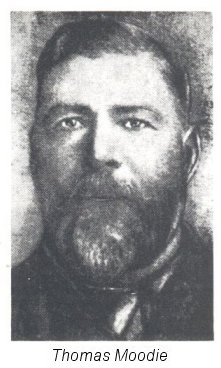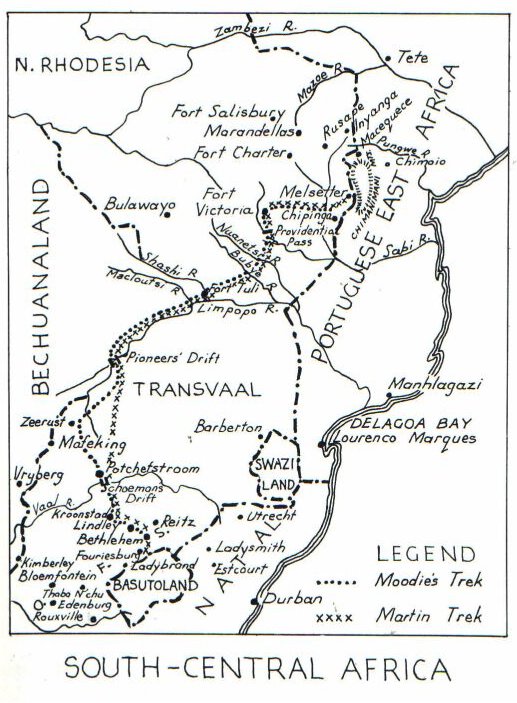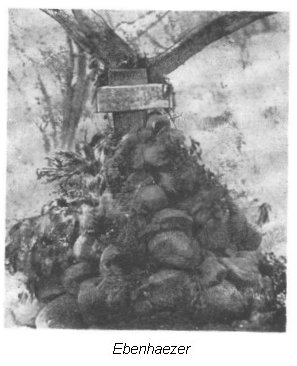
Melsetter owes its existence to the Treks to Gazaland, which have been
fully described in other books: the Moodie Trek was of direct interest, and the
Martin Trek was the main one to Melsetter. In following the early journeys I
have given all the farms their more familiar modern names.
At the end of March 1891, after visiting Gungunyana with Dr. Jameson,
Dunbar Moodie arrived at the farm of his cousin Thomas Moodie at Bethlehem in
the Orange Free State. Thomas and Dunbar were very close to one another in spite
of Thomas�s 20 years� seniority, and between his travels Dunbar had spent
much time as a member of Thomas�s household.
Farming had not prospered for Thomas, and, as he also had a large family,
the possibility of trekking to a fresh environment where there would be enough
land to settle all his sons made him keenly interested when Dunbar arrived full
of enthusiasm for prospects in Gazaland, which he described as the loveliest
country he had ever seen, this gem of the north, this Promised Land, and they
persuaded neighbours also to consider the move.
Dunbar set off for Cape Town in April 1891 and outlined his colonising
plan to Rhodes, who immediately appreciated what a tremendous advantage it would
be to have a European settlement in Gungunyana�s country as it would help with
the Portuguese problem and be of benefit to the the Company�s trans-Limpopo
venture as a whole.
Dunbar returned to report favourably to Thomas, and carried on via
Beira to make arrangements with the Administrator in Salisbury. There he again
met Rhodes, who had travelled overland, and after the interviews Dunbar wrote to
the Company�s secretary in Cape Town that Rhodes had approved of the scheme to
bring a hundred farmers into the country and wished to have their names.
Dunbar took back to Bethlehem a copy of the Company�s Mashonaland
Settlement Scheme, of which two provisions directly affected the Gazaland
settlers. One was that farms were to be of 1 500 morgen, with an annual rental
of �3; this was considered too small, and was later increased to 3000 morgen
(approximately 6,333 acres) at an annual quitrent of �6. The other was the
stipulation of beneficial occupation of the land within five months of the grant
by the owner or a European manager approved by the Company. This clause was
difficult to fulfil when things became really tough later and farmers
wanted to try to earn some money away from their farms.
Those planning to trek held meetings in the Orange Free State and
elected Thomas Moodie to be their leader. For various reasons some of those who
originally expressed their intention of joining the trek were unable to do so,
and as many of these were men of ability and influence Thomas feared that the
Trek might not be the success he had expected.
All preparations were made for those who were determined on the
journey, and on 5th May 1892 a caravan of 16 wagons left Bethlehem on the long
trek to the north. Dunbar did not accompany them: he went via Beira and Umtali
to Salisbury, and expected to join up with them well inside Rhodesia shortly
after his arrival there in August. He had great difficulty, however, in locating them, and it was two weeks later,
after he had ridden 450 miles, that he found them barely out of
Bechuanaland.
Four months had confidently been allowed for the Moodie Trek to travel
from Bethlehem to Gazaland. but such were the hazards and hardships of the trek
that it took them four months to reach the Rhodesian border only, and another
four months of weary trekking before they crossed the Sabi river. By the time
the Trek reached Fort Victoria there was dissension about leadership, their
ultimate destination, and various other matters, and so the party split up and
the majority took up land between Fort Victoria and Salisbury.
Seven wagons only, with fourteen men, four women and three children,
left Fort Victoria to travel to their goal in the east. Their journey was full
of incident and hardship: a road had to be found and negotiated, the Sabi river
had to be crossed, the Driespanberg (up whose steep slopes it was necessary to
use three spans of oxen for each wagon) had to be surmounted, there was a threat
of tsetse fly, and nearly all members of the party were ill with malaria.
They overcame all the difficulties, and the trek ended when they reached
Waterfall on 4th January 1893, where Thomas Moodie settled with his family.
Ernst du Plessis, the dependable second-in-command of the trek, chose Clearwater
for his farm, where his son and grandsons still live today, Dunbar established
himself with his wife Sarah on Kenilworth, and others also settled around the
Chipinga area.
The presence of the missionaries at the already-established Mount
Silinda Mission was a great help. Dr. Thompson�s medical services were soon
called upon as many homes were built on low-lying ground and the toll of malaria
was great. His selfless service to the community was deeply appreciated by
all.
The trekkers� arrival was followed by a sad tale of hardship, struggles
and deaths, and it was particularly sad for all that Thomas Moodie, their wise,
courageous and strong leader, died before the end of that first year, and was
buried on Waterfall.
While the Moodie party was installing itself, an advertisement in The
Friend of Bloemfontein in January 1893 offered land near Macequece in Mozambique
to Free State farmers. Marthinus Jacobus Martin was then a member of the Orange
Free State Parliament and a prosperous farmer. After he had discussed the
advertisement with friends he wrote to make further enquiries about the farms
offered. In April, when he had received replies, a meeting in Bethlehem
discussed the possibility of moving up to this well-described land, and decided
to send a commission to study the land and conditions.

In August four farmers, including Martin, left Durban by boat, and at
Beira they were welcomed by the Governor of Mozambique and given permission to
visit Gazaland. They were supplied with guides, and travelled from Beira along
the Pungwe river to Fontesvilla and then overland to Chimoio (today�s Vila Pery)
and Macequece. Th~y considered the ground in that area was too low-lying, so
they went further south searching for highveld farms, and when they reached
Clifton they saw the type of country for which they were looking.
They learned from local inhabitants of a European settlement a few days�
journey away, and made their way to Waterfall, where they were given a great
reception by the Moodies.
Dunbar, as the Company representative, took them round on a visit of
inspection. They rode over towards the Nyahode river and the Chimanimani
Mountains, and travelled across Lemon Kop and Cecilton, and all decided that
this was the area in which they would like to settle. After ten days� riding
Marthinus Martin had chosen his farm Rocklands, and they all planned to apply to
the Company for permission to settle along this range of mountains, and not to
follow up their original intention of settling in Mozambique. In the event
Martin was the only one of the four explorers who carried on with the
plan.

Two months later, travelling via Beira, they arrived back in the Free
State. Martin was enthusiastic about what they had seen, and arrangements could
not have been in better hands. He made full enquiries from the B.S.A Co. and
from Mozambique officials about the exact position regarding Gazaland, and from
Beira was assured that the territory was British.
The B.S.A. Co. said that he could have the eight farms for which he applied
if he left the following April to occupy them, as it was an attractive place and
other people might be interested. Martin went to Kimberley to interview Rhodes,
who encouraged this proposed agricultural trek as he was very keen on settlement
by family units, and trusted that Martin�s people would be successful and turn
out the Company�s strongest supporters on the Eastern Border.
To the distress of his constituents, as he had worked untiringly in the
interests of the Free State people, Martin resigned as a member of the
Volksraad. He showed great thoroughness in preparations for the trek, including
getting in touch with the Rev. Andrew Murray, Moderator of the Dutch Reformed
Church in South Africa, to ask him to assist in starting a proper congregation
in the north.
His party gradually grew to over a hundred, and he applied successfully
to the B.S.A. Co. for more land for the extra families.
On 10th April 1894 the Martin Trek of 24 wagons and 104 members moved
slowly out of Fouriesburg. By arrangement they were joined by other families en
route. President Kruger granted them permission to travel through the Transvaal,
which made the first part of their journey shorter than the Moodies� had
been.
The trekkers travelled with good strong selected oxwagons, and brought
clothing, materials, medicines and food which included boer-meal, rice, raisins
and other dried fruits, coffee beans, sugar, suet, etc. The first part of the
journey went very well while food lasted and oxen were strong, but in the latter
pan provisions were short, oxen and horses died, people got ill, and two members
of the party died.
Each family wagon was like living in one�s own home, and all had their
individual prayers except on Sundays or other arranged occasions when everyone
gathered together. There was never any travelling on Sundays.
Everyone had his or her work to do. Mothers had to make bread, cook
food, mend clothes, do the washing, see that the children were clean, and at
times had to gather wood or help where a hand was needed. Fathers had to drive
and grease the wagons, keep the brakes and other gear in repair, and hunt for
the pot. Boys of seven years and older had to herd the oxen when outspanned, be
voorlopers leading the oxen when travelling, or drive the loose cattle following
the wagons. Girls had to be mother�s help, and act as nursemaid � some of the
babies were under one year old.
At times of danger great piles of wood were made round the laager for fires
at night to keep lions away from the cattle. The Martin trek was accompanied by
four Zulu and four Hottentot men and two Hottentot women servants: they
repaired the trek gear and helped generally.
Men had wide-brimmed hats, trousers very narrow round the leg, and no
belts unless it was a bandolier full of cartridges. They wore braces, sometimes
made of leather, and everyone wore waistcoats with four small pockets: their
jackets were seldom used.
Boys wore shirts and three-quarter trousers which came below the knee,
held up by cross braces, and made of dark brown cotton velvet cord or buckskin
cloth which, when aged, washed nearly white. Footwear was made of hides or skins
tanned with the bark of a tree and sewn with riempies (leather thongs) or pegged
with shoepegs. When their felt hats wore out, the women had to make hats from
any material: perhaps from an old pair of trousers which had worn out in parts.
After arrival in Gazaland hats were made of lala palm plaited and sewn
together: boys had narrow brims, girls wide brims, but the kappie was more
popular for girls and women. Girls dressed in coloured prints or gingham. All,
or almost all, had Sunday-go-to-meeting clothes hidden at the bottom of a tin
trunk.
The trekkers brought caustic soda, so if an animal died in good
condition the fat was rendered down and large bars of white soap were made. Some
had moulds for casting candles and water candles were also made by a long
process: fat was melted in a bowl of boiling water, and all the wicks, on a thin
rod, were dipped into the fat, put out to cool, then dipped again, and this was
repeated until the candles were thick enough.

When the Trek arrived at Buffelsdrift it was decided to erect a
memorial of stones in memory of their safe arrival on the Gazaland border and as
a sign of their thankfulness for God�s faithful guidance and care on the long,
dangerous and exhausting journey. On the 16th October they celebrated the day of
Thanksgiving, and the spot and memorial were called �Ebenhaezer�, from I Samuel,
7.12: �Then Samuel took a stone, and set it..., and called the name of it
Ebenezer, saying, hitherto hath the Lord Helped us.�. The members of the party
decided that once every five years they would gather there on the 16th October
and celebrate the day.